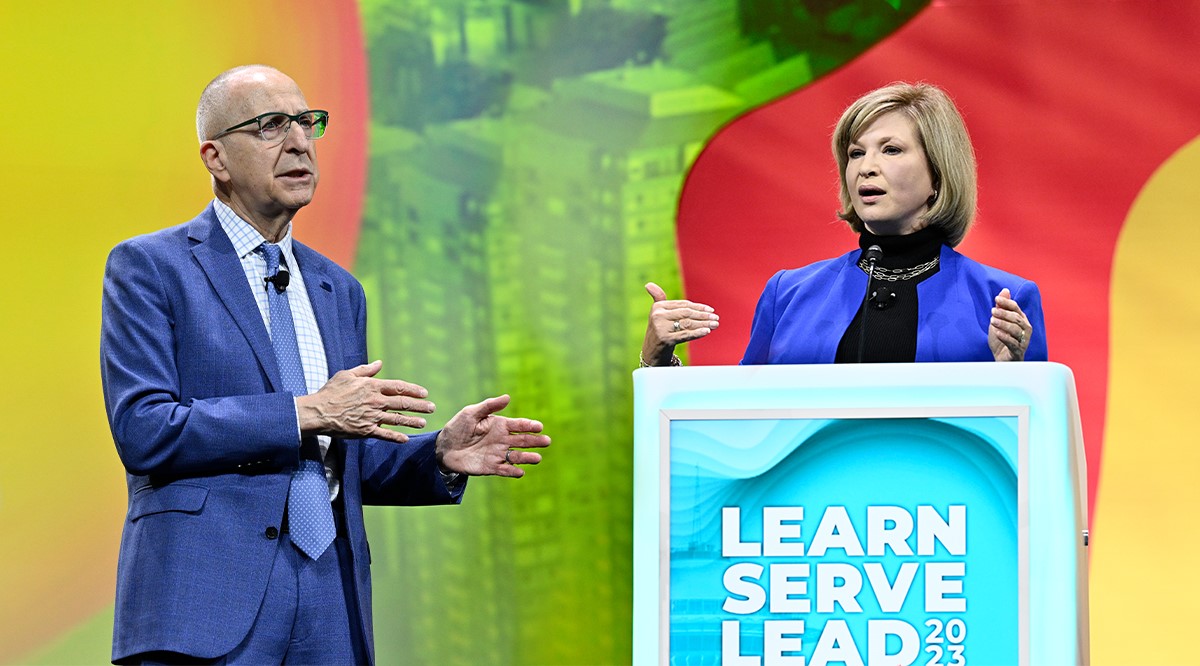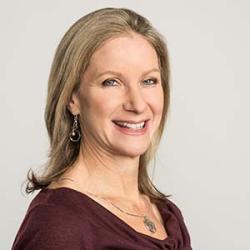
AAMC President and CEO David J. Skorton, MD, and AAMC Board Chair LouAnn Woodward, MD, urged physicians and scientists from U.S. medical schools, teaching hospitals, and health systems on Nov. 5 to work together to overcome the challenges facing academic medicine and to stay steadfast in their commitment to improve the health of all.
At a time of tremendous political, economic, and social upheaval, both domestically and abroad, Skorton acknowledged the continuing “headwinds” facing those in health care, including opposition to diversity, equity, and inclusion; climate change; the challenges posed by artificial intelligence; and more. “But tempting as it can be to feel discouraged about the path ahead and these discrete challenges … and believe me, I’m not immune to that feeling from time to time … I’m here today to share why, overall, I believe there’s great cause for hope,” Skorton told the more than 4,600 attendees of Learn Serve Lead 2023: The AAMC Annual Meeting during the leadership plenary held in Seattle.
Woodward similarly identified challenges facing the country and academic medicine — including unequal access to care, political polarization, and “a never-ending tsunami of bad news and drama.” But she urged the audience to recognize that every situation, every moment in time, can be both good and bad — “the two sides of a coin” — and that individually and collectively academic medicine must respond to both.
“I very much believe that in the future when we look back on this time, it will be looked upon as a great time for science and medicine,” said Woodward, vice chancellor of the University of Mississippi Medical Center and dean of the UMMC School of Medicine. In the face of seemingly endless bad news, though, the way forward is to “keep our focus on the students, the science, the patients, and the communities we serve.”
Woodward urges leaders to look for good amidst the bad
Woodward began her address with a personal story of treating two patients with a sore throat one right after the other. One was an otherwise healthy young college student, who had health insurance through his parents, and who didn’t want his mild illness to interfere with his schoolwork. The other, who hadn’t seen a doctor until then because he had no transportation to the hospital, presented with a massive tumor on his neck.
“Two patients presenting to the same emergency room on the same day at the same time with the same chief complaint. But each representing the opposite ends of the health care spectrum. Two sides of the coin. Each representing the dichotomy of life and means,” Woodward recalled. “In some ways, what makes this story so meaningful is it isn’t special or unusual at all.”
Woodward then recounted another story, this one from the summer of 1963, when a young surgeon, James Hardy, MD, performed the world’s first human lung transplant at UMMC. During that surgery, a gunshot victim came into the hospital, but ultimately died. The victim was civil rights leader Medgar Evers, who had been ambushed outside his home. Two surgeries — one successful, the other not. The good and the bad.
“In the current frenzy of dissension, disagreement, discord, and conflict, how do we present the other side of the coin? The positives. The good side. How do we prevent the negatives from overtaking us?” Woodward asked. “In our current environment where one side of the coin is disagreement and conflict, I encourage us to focus most of our attention on the other side. To be attentive, to listen, to engage in real and honest dialogue, to put an emphasis on what brings us together rather than what divides us. Do all this, while keeping a laser focus on the students, the science, the patients, and our communities.”
Skorton expresses optimism and profound gratitude in the face of challenges
Skorton began his remarks with an acknowledgement of the tremendous pressures facing those who work in health care, including financial challenges and staff shortages.
But he is bolstered by the knowledge that in times of crisis, academic medicine has unfailingly risen to the occasion, including during the HIV/AIDS epidemic, in the search for novel cancer therapies, and most recently, during the COVID-19 pandemic.
“I truly believe that we, as a broad community of academic medicine, have the stamina, resources, and creativity to overcome even our most troublesome problems,” Skorton said. “We can succeed if we walk this path, together.”
One arena in which collective action is needed is to counter opposition to making the medical profession more diverse, equitable, and inclusive.
“We do this not based on politics or ideology, but on accumulating data. … For there is significant evidence that more diverse health care teams improve trust, communication, and patient satisfaction, and growing evidence that diverse teams improve health care outcomes and can save lives,” Skorton said.
In the last year, the AAMC has been working to inspire students as early as middle school to pursue a career in medicine, and has announced a major new investment in the Summer Health Professions Education Program, the largest and most successful prehealth academic program in the country.
Skorton also acknowledged recent criticisms of the AAMC, including perceptions that it’s a left-leaning organization; that it has been slow to innovate and improve its services such as the AMCAS® program, ERAS® program, MCAT® exam, and others; and that it is solely focused on revenues to the detriment of learners.
To address the first concern, the AAMC has begun “holding space for divergent views” including this year’s Learn Serve Lead opening plenary on free speech. “My hope is that as we learn to listen more, we’ll rediscover the core values that we all have in common, despite our differences,” Skorton said. “Those values — and our mission to achieve better health for people everywhere — are ultimately why we’re all here.”
The AAMC has also made significant investments in its services, including a recent collaboration with Thalamus to improve the residency interview process.
Lastly, the AAMC has been working to mitigate the financial pressures on learners. “In the next 90 days, we will be introducing a fundamental change in our ERAS fee structure based on the input of learners and the student affairs community,” Skorton said. The AAMC also has introduced a major financial assistance program for the ERAS program, modeled after the long-standing fee assistance programs for the MSAR® guide, the AMCAS application, and the MCAT exam.
Noting the many other initiatives underway both at the AAMC and its member institutions to improve the health of all, Skorton ended his talk much as he began — with confidence in the power of academic medicine to overcome adversity.
“Together, we will team up with each other and with our communities to diversify the workforce. Together, we will navigate new technologies like AI in a way that supports health equity, rather than worsening inequities. Together, we will address climate change through the lens of health, to promote environmental justice. And so much more.
“We will rise to the occasion. No one of us, no matter how well equipped, can solve these complex challenges alone. Thankfully, we don’t have to. We have each other. We have what it takes to overcome whatever lies ahead of us — our collective power and strength.
“Let’s do this! Let’s walk this path … together.”
